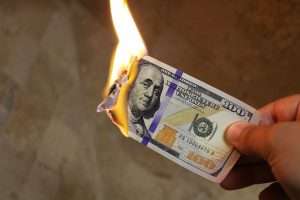What Procedures Improve Cash Flow?

The cash cycle procedures are undoubtedly the most important process procedures to optimize for any business – from when you spend money to when you get money. The are four key cash flow control procedure areas. Learn how cash flows through these areas to make the cash to cash cycle. What procedures improve cash flow?
Cash Conversion Cycle and Cash Flow Procedures
One way to express this cash flow is the control over the length of time between the purchase of Inventory (raw materials, etc) and the collection of accounts Receivable created from the sale of your product — also called the cash conversion cycle. Why is this cash process so important? Because this is how your business produces cash.
Cash to Cash Cycle Definition
By definition, the cash to cash cycle is a financial ratio that shows the length time for which a company must finance its own inventory. It measures the number of days between the initial cash outflow (when the company pays its suppliers) to the subsequent cash inflow (Accounts Receivable).
Cash-to-Cash Cycle Formula
This can also be expressed by the Cash-to-Cash Cycle formula:
Stock Days + Debtor Days – Creditor Days = Cash-to-Cash Cycle
OR
Inventory Conversion + Receivable Conversion + Payables Conversion = Cash Conversion Cycle
Stock Days (Inventory Conversion)
Stock days represents how long it takes to use stock on hand or inventory conversion period. The formula for inventory conversion is Average Inventory / Cost of Goods Sold / 365.
Debtor Days (Receivable Conversion)
Debtor days represents how long it takes to collect from your those that owe your company money. This is typically your accounts receivable conversion period. The formula for receivable conversion is Average Accounts Receivable / Sales Revenue / 365.
Creditor Days (Payables Conversion)
Creditor days represents how long it takes your company to pay your creditors or accounts payable. This is your accounts payable conversion period. The formula for payable conversion is Average Accounts Payable / Purchases / 365.
So, for example, a company that keeps its stock for on average 30 days, gets paid by its debtors on average within 30 days and pays its creditors on average within 30 days will have a cash-to-cash cycle of 30 days.
Good Cash Flow Control
Companies that receive cash from their customers at the point of sale and that have their inventory under good control will have a short cash-to-cash cycle. A company could even have either a negative cycle or a cycle time of zero.
Zero Cash Cycle
For example, if a business’ receivables and payables are held in check at 30 days while inventory runs at Just-In-Time (JIT) levels, then the cash cycle is zero – meaning that this company is in good shape with no working capital needs. And, of course, when receivable days are less than payables with JIT inventory, then the company will enjoy a positive cash-to-cash cycle – creating more cash on hand.
Poor Cash Flow Control
On the other hand, however, if a company lowers accounts payables down to 15 days and allows accounts receivables to grow to 45 days, while inventory remains at steady levels, the cash cycle will be high. Now, working capital will be constrained to compensate for these inefficiencies.
Operations Assessment and Working Capital
Businesses live and die by the cash generated from operations. If your operations don’t create cash, then they consume it. A cash-consuming operation means that you have negative cash flow and you are living on financing (debt or equity). But the Cash to Cash Cycle also shows you the amount of working capital you have committed to your organization.
Just add the number of days of inventory to the number of days of receivables outstanding, and then subtract the number of days of payables outstanding. The result is the number of days of working capital your organization has tied up in managing your supply chain. This can be quite a significant number – one not to overlook.
Process and Procedures Investments
Did you realize that working capital is the investment you are making in the inefficiencies of your processes and procedures plus your investment in your suppliers’ and your customers’ inefficiencies too? Investing in inefficiency is like burning cash.
In other words, if you do not monitor inventory, accounts receivable, sales and marketing and accounts payable to ensure a healthy cash-to-cash cycle, then your working capital needs will not maintain a strong cash flow. The Cash Flow Process will be out of control, and will not be optimized to create the greatest amount of financial effectiveness for the company.
Procedures Improve Cash Flow
In order to increase your cash flow, you need to increase the velocity of your cash to cash cycle. This is done by reducing the inefficiencies found in your processes, your suppliers’ processes and your customers’ processes.
The procedures to improve cash flow include:
- Inventory Control Procedure (increase your inventory turns)
- Accounts Receivable Procedure (reduce your days sales outstanding)
- Sales and Marketing Procedures (increase cash sales)
- Accounts Payable Procedure (increase your days payables outstanding)
So now you can see the relationship of your Cash Flow Control Procedures and your cash flow, your working capital and your cash to cash cycle. The result is a decrease in your working capital and an increase in your cash. And, as we’ve seen, this can be a significant cash flow number – again, one that you shouldn’t overlook.
Policies and Procedures Solve Business Problems
The Top Ten Core Business Policies and Procedures you will need can be found in the Bizmanualz CEO Company Policies Procedures Manuals bundle. How quickly could your business problems be solved using effective policies and procedures? Try free policies and procedures for your business.















Leave a Reply